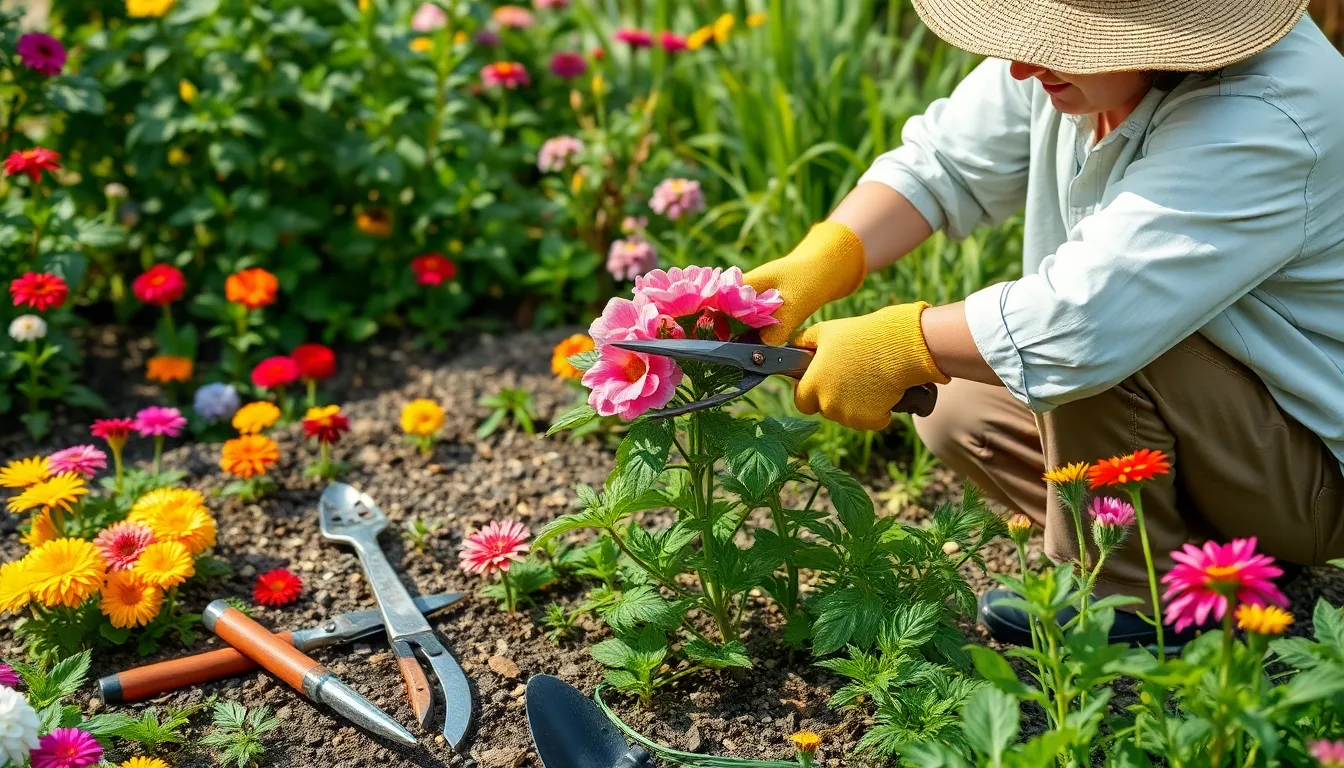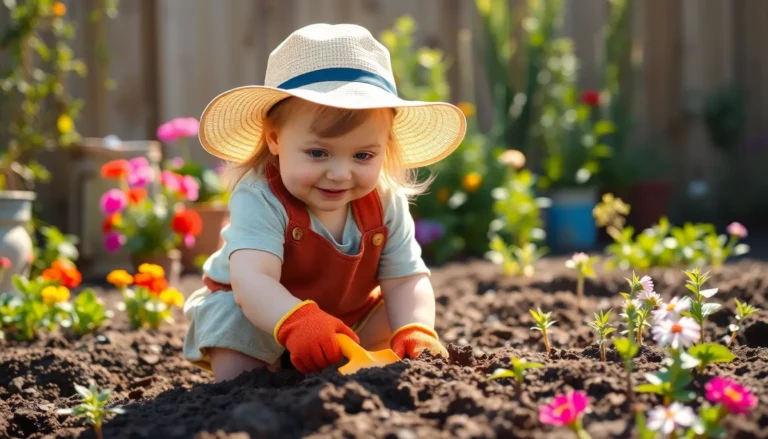In the world of gardening, having the right cutting tools can make the difference between a flourishing oasis and a jungle of despair. Picture this: you’re ready to tackle that overgrown hedge, but your trusty shears are as dull as a butter knife. It’s time to upgrade your arsenal! With the right tools, pruning becomes less of a chore and more of a delightful dance with nature.
Garden cutting tools aren’t just about snipping away; they’re your secret weapon for transforming your green space. From sleek pruners that fit like a glove to robust loppers that can tackle branches thicker than your morning coffee, the right gear can turn any amateur into a gardening guru. So let’s dive into the world of garden cutting tools—where sharp edges meet sharp wit, and every cut brings you closer to your dream garden.
garden cutting tools
Garden cutting tools play a crucial role in effective gardening. Pruners assist in trimming small branches and shaping plants, while loppers tackle thicker branches with ease. Shears serve well for hedges and shrubs, promoting neat appearances in landscapes.
In addition to these, saws are vital for larger branches or trees, allowing for precise cuts that minimize damage. Each tool has its specific function, ensuring gardeners can tackle various tasks efficiently.
Choosing the right tool improves not only efficiency but also safety. Dull tools can lead to accidents, whereas sharp, well-maintained tools minimize risk and enhance overall performance. Quality makes a difference, as sturdy materials like stainless steel resist corrosion and provide longevity.
Maintaining tools is equally important. Regular cleaning prevents residue build-up while sharpening blades ensures every cutting session is productive.
Ultimately, selecting the appropriate cutting tools elevates a gardening experience. With proper equipment in hand, gardeners find satisfaction in achieving neat, well-maintained green spaces. This ensures enjoyment in the gardening process and better outcomes for plants and landscapes.
Types of Garden Cutting Tools

Garden cutting tools come in various types, each serving unique purposes in maintaining plant health and aesthetics. Understanding these tools helps gardeners choose the right equipment for their needs.
Handheld Tools
Handheld tools are essential for precision cutting and detail work. Pruners are popular options, ideal for trimming small branches and deadheading flowers. Garden shears assist in shaping plants and managing hedges. Loppers handle thicker branches, providing extra leverage. Users appreciate the comfort of ergonomic designs, which make prolonged use easier. Quality materials like stainless steel enhance durability, ensuring tools resist rust and wear. Maintenance involves regular cleaning, sharpening, and lubrication to keep tools functioning optimally.
Power Tools
Power tools simplify larger tasks and expedite the cutting process. Chainsaws are effective for severing thick branches and felling trees. Hedge trimmers allow for quick shaping of shrubs and hedges, making them a time-saving choice. Some electric pruners offer precision cutting with less physical strain. Battery-powered options provide mobility without the hassle of cords. Each tool requires safe handling practices to prevent accidents and injuries. Regular maintenance ensures these tools remain efficient and reliable during use.
Essential Features to Consider
Selecting the right garden cutting tools involves understanding key features that enhance performance and safety. Focusing on material quality and blade design provides critical insights for effective gardening.
Material Quality
Durability stems from choosing tools made with high-quality materials. Stainless steel stands out for its resistance to rust and corrosion, ensuring longevity through various weather conditions. Lightweight aluminum also offers strength without compromising maneuverability. Tools crafted from these materials require less frequent replacement, ultimately saving money. Ergonomic grips often complement quality materials, resulting in a comfortable user experience. Over time, the right materials significantly contribute to overall gardening efficiency.
Blade Design
Blade design directly impacts cutting performance. Sharp, precision-ground blades enhance the effectiveness of cuts while reducing effort during use. Curved blades excel in shaping tasks, whereas straight blades offer versatility for various applications. The length and width of the blade play crucial roles in maneuverability and control. Thicker blades provide stability for heavy-duty tasks, while thinner ones cater to intricate cuts. Selecting tools with the right blade design ensures optimal results in maintaining healthy plants.
Maintenance Tips for Longevity
Proper maintenance of garden cutting tools ensures their longevity and optimal performance. Regular cleaning prevents dirt and sap build-up, which can affect cutting efficiency. After every use, wipe the blades with a clean cloth to remove debris.
Sharpening tools keeps blades effective. Use a sharpening stone or file specifically designed for garden tools. Aim for a sharp edge at the appropriate angle, generally between 20 to 30 degrees. For heavy-duty tools like loppers and shears, consider professional sharpening if necessary.
Additionally, lubrication plays a key role in maintenance. Apply oil to pivot points and joins to keep tools moving smoothly. A few drops of light machine oil suffice to prevent rust and corrosion, extending the lifespan of the tools.
Storage conditions impact longevity. Store tools in a dry, cool place away from excessive moisture. Hang shears and loppers on a pegboard or in a toolbox to prevent accidental damage.
Inspect tools regularly for wear and tear. Check for loose screws and damaged blades. Replace any worn-out parts promptly to ensure safety and functionality. Only use tools for their intended purpose to avoid unnecessary strain and potential breakage.
Investing time in maintenance increases productivity and enhances the overall gardening experience. Following these maintenance tips helps ensure that cutting tools remain reliable, making gardening tasks more enjoyable.
Safety Best Practices
Using garden cutting tools requires attention to safety. Wear protective gear such as gloves, eye protection, and sturdy footwear to prevent injuries. Proper clothing includes long sleeves and long pants to shield the skin from sharp blades and rough materials.
Before starting, check tools for damage or defects. Inspect blades for sharpness; dull blades can slip and cause accidents. Ensure that all tools are clean and well-maintained to optimize safety during use. Keep work areas free of debris and clutter to maintain clear pathways.
Proper handling is crucial for safety. Grip handles firmly and use both hands when operating power tools. Avoid loose clothing that can catch on tools or plants. When using saws or shears, position hands at a safe distance from blades.
It’s essential to be aware of surroundings. Look out for others nearby, especially children or pets, while trimming or cutting. Always direct the cutting path away from the body and avoid overreaching when using tools at heights.
When storing tools, place them in a secure area out of reach of children. Hanging tools on a wall or placing them in a dedicated storage box helps prevent accidents. Lubricate tools regularly to ensure they operate smoothly and safely.
Sharing knowledge about tool safety enhances gardening experiences. Discuss safety practices with fellow gardeners to foster a culture of safety. Adopting these safety measures ensures gardeners work effectively while minimizing risks.
Conclusion
Investing in the right garden cutting tools is crucial for any gardener looking to enhance their experience and achieve beautiful results. With a variety of options available from handheld to power tools, choosing the right equipment tailored to specific tasks can make all the difference. Regular maintenance and safe handling practices not only prolong the life of these tools but also ensure a safer gardening environment.
By prioritizing quality materials and ergonomic designs, gardeners can enjoy improved performance and comfort. Ultimately, the right cutting tools empower gardeners to create and maintain stunning landscapes, turning their gardening endeavors into a more rewarding and enjoyable journey.




